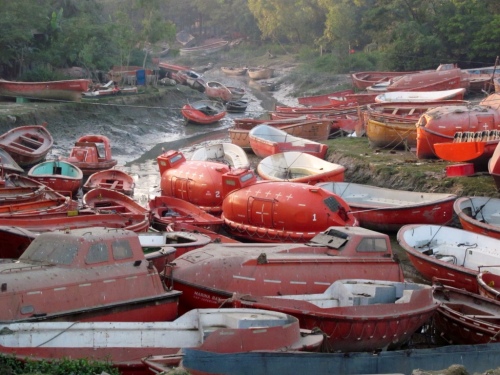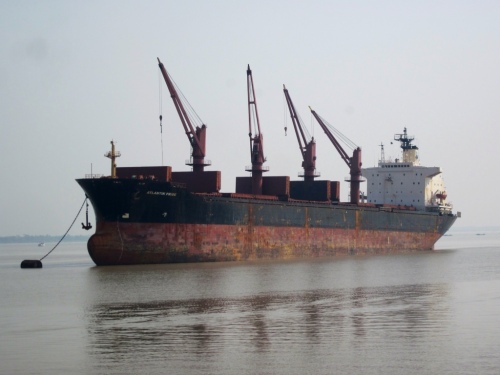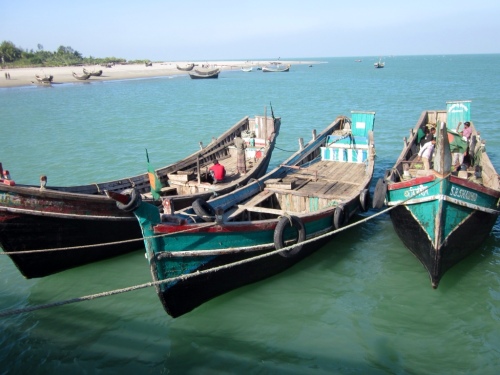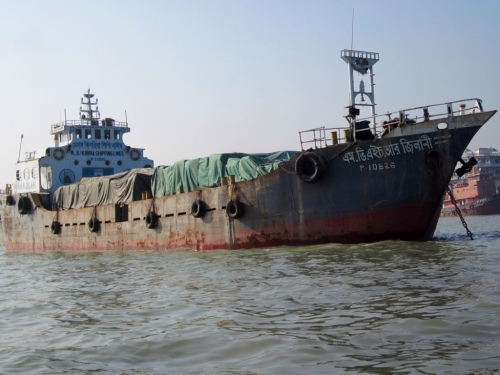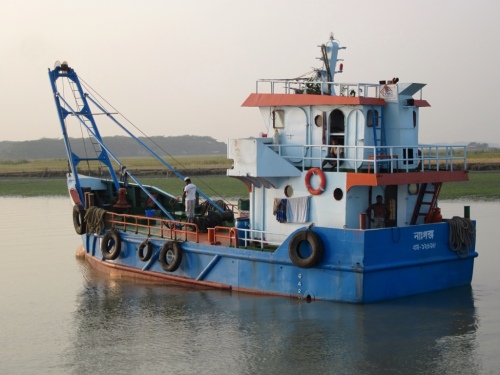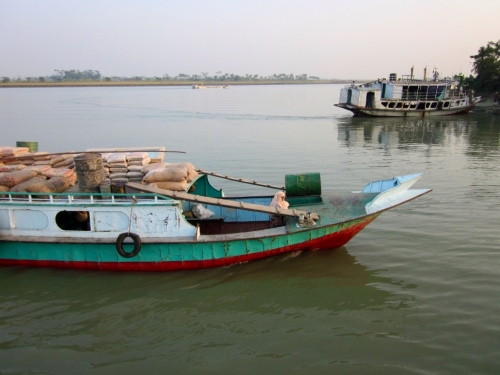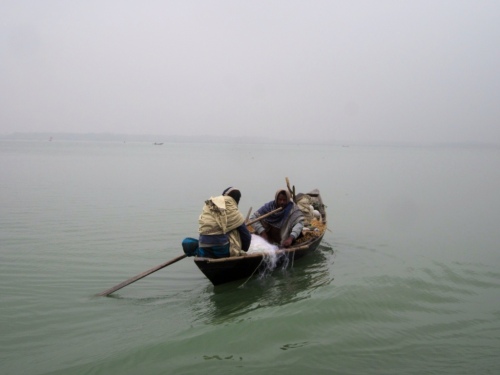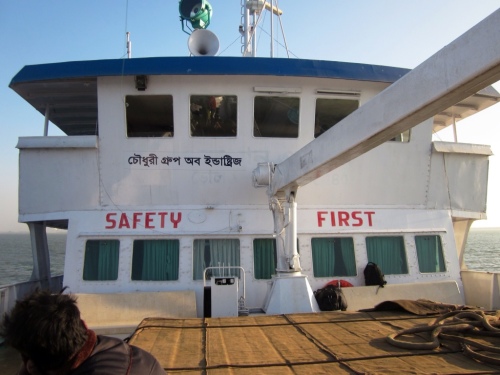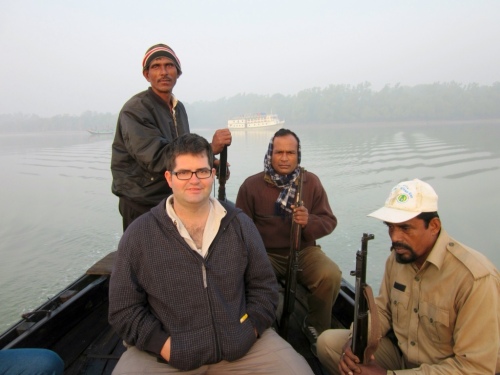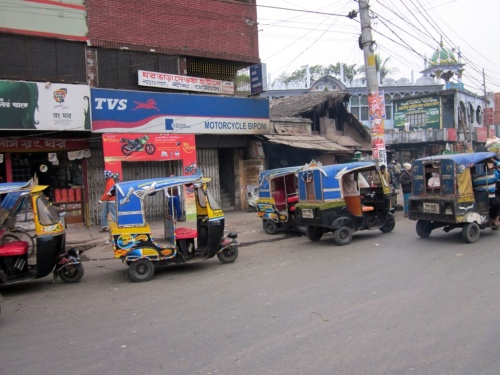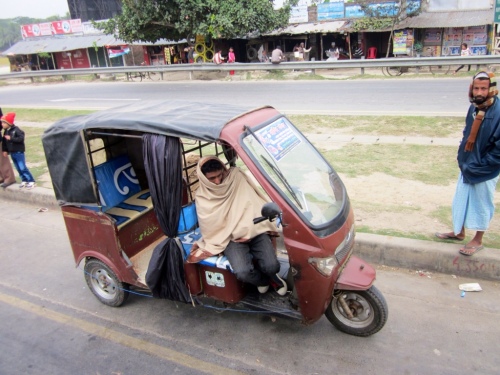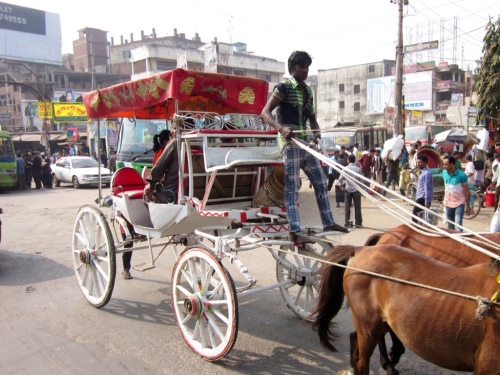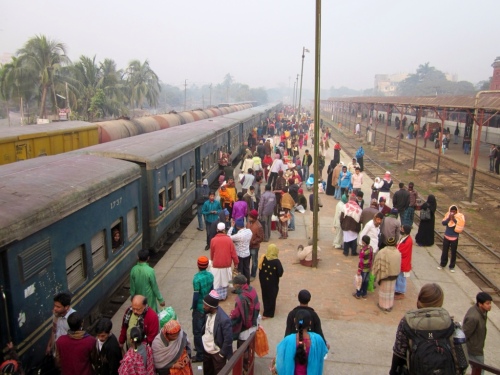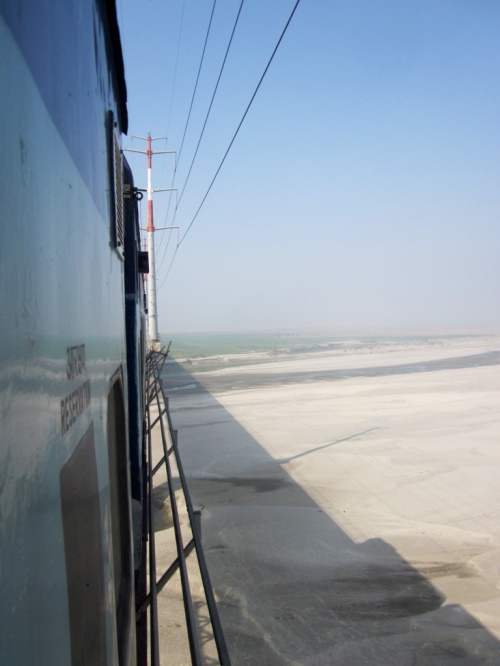With a population of 160 million people, Bangladeshi transportation
comes in all shapes, colours, and sizes. Find yourself a
seat/platform/cage, whack some wheels on it, and you have yourself a
rickshaw. All aboard!
Cycle Rickshaw!
These are everywhere, and are the default mode of transport for short
distances. Old Dhaka is full of them. I walked a kilometre along Cycle
st (Bangshal rd), before I found a gap in the rickshaw traffic jam and
could cross the street! They also have some pretty gnarly artwork.
Pretty cheap fares, around 15 – 30 taka. No extra charge for a third
person, luggage, or cattle if you can all fit
Van
I think van means anything with a flat wooden platform.
CNG
CNG stands
for compressed natural gas. These are great for longer distances. Cram
as many people in as possible. Great for weaving in and out of traffic
and for playing chicken with larger vehicles, such as buses. No extra
charge for the cage.
Battery/Auto Rickshaw
These things are battery powered, and despite their appearance can
actually go pretty quick. More room than a CNG, and there is no cage, so
you can hang out the side.
Misc…

Tempo?

Another Tempo?

Bamboo Van?

This thing is so overloaded that I have no idea...
Horse cart
Pretty
popular with the Bangladeshi domestic tourists as far as I can tell. I
think these go from Gulistan crossing in Old Dhaka to the Sadarghat and
back.
Rowboat
Pretty common way to cross rivers. These photos are from the Sadarghat in Dhaka. 2 taka set price.

Ferry and Launch
Some of these are huge, and carry a lot of people. Like lots of people. Many routes run overnight.
Moto boat
These are bigger versions of the rowboats, normally used if the river
is really wide. They row a short distance, and then turn on the motor.
These photos are from the Karnaphuli river, in Chittagong. About 5 taka
from memory.
The Party Boat
Get there, get on board, and get amongst it.
Train
Bangladeshi
trains are great. They are pretty comfortable, and not too crowded.
There's a constant stream of buskers, beggars, and hawkers selling food,
so they're never boring, and are a great way to see the country. The
first 4 photos are from the Paharika train, from Chittagong to Sylhet.
We had 1st class chair tickets.
These two
photos were taken on the train from Dhaka to Kolkata. I was in the
cheapest class. It was only half full, and even had a clean toilet! And
they let me hang out the door too.
There are also some
other forms of transport in Bangladesh that you're probably already familiar with.
And…
Bangladeshi bus rules
1. If less than half of your passengers are vomiting at any one time, you're not going fast enough.
2. Rickshaws, motorbikes, other buses, cars, animals and small
children are a blight on gods green earth, and must be destroyed at all
costs. 10 points for hitting any of the above
3. Horn
4. Suspension is for pussies, and maintenance is for girls.
5. Any object in front of you MUST be overtaken, regardless of
oncoming traffic. It is your sworn obligation to god and country. Bonus
points for blind corners.
6. More Horn
7. If you arrive at a blind corner and have somehow failed to find
another vehicle to overtake, you are a disgrace to your country, your
fellow bus drivers, your father, his father, Cox's Bazar, god, and all
of humanity. Taking the corner on the wrong side of the road whilst
loudly honking your horn is the least you can do to attempt redemption.
8. HORN!!!
9. Don't stop to let passengers on or off. Slow down slightly, and
speed up just before they grab the door handle. You are a soldier in the
war on obesity.
10. Horn.

Looking worried, Barisal to Khulna bus
They're
actually not quite that bad… Sort of… The minivan we caught in Samoa
when we were playing at the 2010 jazz festival is still the worst bus
ride I've been on. A drunk driver, up on 2 wheels at times, and he
wouldn't stop despite frequent protests.
The Bangladeshi drivers are pretty reckless, and Bangladesh does have
a high rate of road deaths. Although a large proportion are made up of
the passengers and drivers of smaller vehicles, such as rickshaws, that
are hit by larger vehicles. You are actually statistically more likely
to die on the NZ roads than the roads in Bangladesh, when you factor in
the number of people travelling every day, and the size of the
population. That fact is completely unverified; I just did a quick
calculation on my old Nokia travel phone when I was feeling nervous on a
bus ride. It made me feel better.
A Danish girl in my hostel here in Kolkata told me a story last
night, about a particularly suicidal bus driver in the Indian mountains.
Everybody on the bus, Indians and foreigners alike, were scared witless
and shaking. Except for one Buddhist monk, who was laughing. He said to
her 'The worst that happens, is we die!'… Monks aye.

#instagram, #zen
Buses in
Bangladesh are frequent, cheap, convenient, and are definitely an
adventure! There is a lot of overtaking and swerving, and they're not
always that comfortable. I'm only 170cms, and my legs would often be
hitting the back of the seat in front. Try and get an aisle seat, or a
seat in the back row. I found that when i sat in the middle seats, I
didn't get much air when we went over a pothole. If you want some
serious air, sit over the axle. My head sometimes almost hit the roof,
no kidding. Normally I put my pack on top of the bus, or in the side
compartment, but sometimes I had to buy an extra seat. No worries tho,
it's cheap, and actually more comfortable than sharing your seat. Buses
don't stop that often, so don't forget your mum.

I'm blessed with the ability to sleep almost anywhere (my claim to
fame is falling asleep during the opening act when Motörhead played in
NZ), and I actually managed to doze off on most journeys. There is a
never ending procession of hawkers selling newspapers, blankets and
delicious food, and if you're really lucky, you'll get to share your
already limited personal space with a grumpy Bangladeshi woman, her
luggage, and her coughing and spluttering (but cute) sick kid.

I avoided the Dhaka to Chittagong highway, which is apparently a
death trap. The other routes are normally clogged with traffic, so you
can't actually go that fast. I caught the Bagerhat to Barisal bus later
than intended, when it was getting dark. It wasn't full, and everybody
looked really worried. I put my hood up and tried to look inconspicuous.
Best to avoid travel at night. Be prepared for some scary moments, and
don't sit on the seat up the front next to the driver, as it's the most
dangerous in a crash. Also, if there is a kid in front of you, close
your window, as they tend to vomit out of theirs, and you don't want
splashback. I'd use the buses again tho, they weren't really that bad. I
spent over 35 hours on the Bangladeshi buses, and I'm still here.
The only thing I'd do differently, is that if i ever catch another
bus that looks like this..

…i.e
full, and it gets on one of these…
… a
vehicle ferry…
I'd
get the hell off the boat to 'take photos', and
get back on when it reached land. If something happened to the ferry,
and when the bus is that full, especially bearing in mind that there are
bars over the windows… Anyway…
I actually have to admit that I really enjoyed them. I met some nice
Bangladeshis, and saw some great scenery. I had an Indiana Jones moment
when the bus drove off with my luggage and I had to jump on. The bus
wallahs are cool too. They hang out the door, yelling the name of the
destination. 'Barisal Barisal! If someone wants to get on, the bus
wallah bangs once on the side to signal to the driver to stop, and twice
to go. A surprisingly efficient system! Except, when the bus wallah is
preoccupied with laughing at the strange foreigner sitting by the door,
who forgot his scarf and is freezing, you may have to run and jump. Our
bus from Bandarban to Ruma Bazar had a long line of convicts chained
together, and a couple of armed guards, the bus from Cox's Bazar to
Chittagong had a prison cell style cage door between the driver and the
passengers, which thankfully was kept open, and it's pretty common for
people to get on carrying what appear to be cans of petrol. The buses in
Bangladesh were an experience!
I'll leave you with some pictures of my favourite Bangladeshi buses.
Cheers!
Joel


Khulna bus
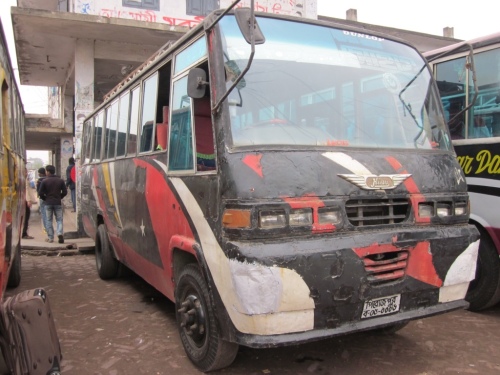
Khulna bus II

Moju Chowdhury Hat to Chittagong bus.

Local bus, Chittagong

Bus, Old Dhaka
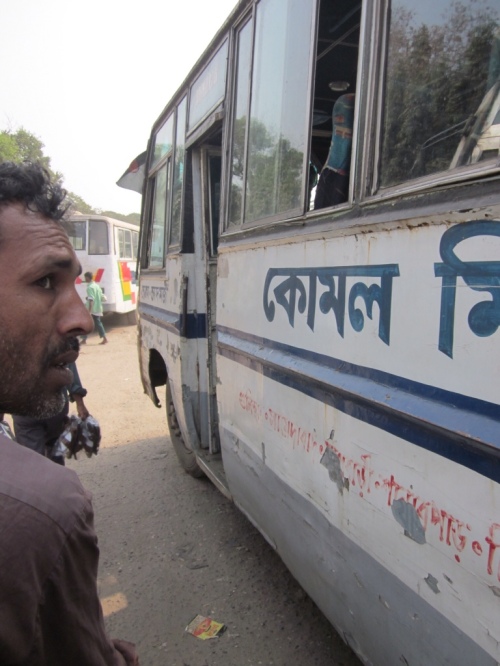
Bus, Old Dhaka
P.S. You can
actually ride up on top along with the luggage. It's technically
illegal, but the rule isn't enforced, even though people are killed by
low hanging power lines and branches every year. I didn't try it. Good
enough excuse to go back!
Source: https://joeliscurious.wordpress.com/2013/02/04/transport-in-bangladesh/







